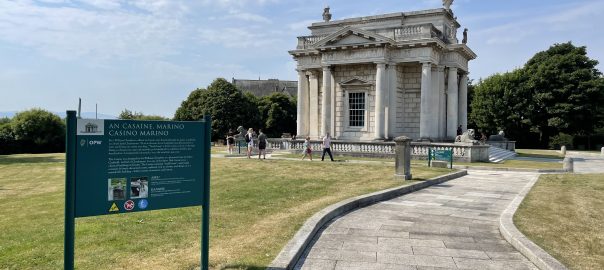Ireland day 0320. Sunday 14 August 2022- CasinoMarino
| Today’s summary |
Took our visitor back to the airport at lunchtime then drove from there to the Casino Marino OPW site on the Malahide Road near Clontarf. A fascinating place. Val went through her exercise programme in the demesne in the evening. |
| Today’s weather |
Dry and bright but cloudy by early afternoon. Hardly any wind. About 22C |
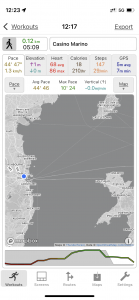 |
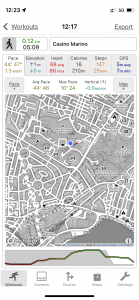 |
Today’s overview location
(The blue mark shows the location of our route) |
Close-up location
(No GPX today) |
Commentary
It’s been very enjoyable having a guest staying with us for the last few days – it’s given us the excuse to visit some favourite old haunts, and all the more fun because the weather has been so perfect and relaxing. So it was all change today when we dropped them off at the airport for a lunchtime flight, and at almost the same time the sky clouded over and the weather forecasts started to foretell rain.
There’s always a slightly empty feeling when people depart – it’s better to leave than to be left behind, as REM once remarked – so rather than just returning straight to an empty flat, we decided to find a new destination which we could explore for the first time together this afternoon.
We didn’t have to do too much searching to find somewhere ideal. The OPW has recently reopened an architectural curiosity, which is conveniently just down the M1 from the airport. It’s the unusually-named Casino Marino which, from old-Italian, means simply “Small house near the sea” (and nothing to do with gambling). As regular readers of this blog will know, we’re big fans of the OPW (it seems to fill the same ecological niche as the National Trust in the UK) so we didn’t hesitate to decide to pay the Casino a visit after our airport trip.
The Casino sits in what used to be the grounds of a large stately home – the Marino – which used to be the seat of the Earl of Charlemont. Sadly the grand house and most of its former large estate have gone now, subsumed under roads and newer housing developments (this area of Dublin is in fact known as “Marino” and you see it on the destination boards of some Dublin buses). All that remains is the Casino, which was the summer house for the estate, located about 1km / ½ mile from the former main house.
The first Earl of Charlemont was James Caulfeild (it really is spelled like that) and he inherited his wealth from an ancestor who was awarded lands in Oxfordshire, UK, for his services to King James I. Caulfeild himself had many interests and became a founder of the Irish Volunteers, which among other things succeeded in securing a measure of legislative independence for Ireland at a time when London was preoccupied with the American war of independence.
Caulfeild was by all accounts a colourful character. He went on a protracted “Grand Tour” of Europe, lasting 9 years, in the 1750s. He developed a taste for all things Italian so he had his (now demolished) main house christened “Marino” (“by the sea”) in an apparent nod to his Italian interests. The Casino was built to be a summer house, in neo-Classical style, for entertaining small (15-25) groups of carefully selected guests. You can see how it appears nowadays, in the banner image at the top of this blog.
The Casino has been restored and it’s open to the public. It’s funny that Val really liked it – but I found it a bit too mausoleum-like for comfort. To me, it felt a bit like the crypt under the O’Connell tower in Glasnevin cemetery. But fascinating and beautifully restored, nevertheless. You can easily see how the views south across Dublin Bay must have been impressive back in the 1700s – before the trees grew and the urban sprawl took over. You can visit most most parts of the building – and we joined a guided tour today, which like that at Brú na Bóinne yesterday – was well pitched and interesting. You can’t go up to the parapet on the roof at the moment, though there are rumours that at some point in the future it may reopen.
We spent a leisurely couple of hours looking round then relaxing in the grounds before returning to the flat for a late lunch. At that point Val took it upon herself to head over to the castle demesne for her aerobic and strength workout programme and I was delegated various supervisory duties. It seemed to go to her satisfaction today, and certainly the cooler temperature today made it a lot more comfortable than the last time she attempted it last week.
Well that concludes the day nicely. There’s lots more background on the Casino itself in the captions to the photos below – so take a few moments to glance through if you’re interested. Otherwise, see you same place, same time, tomorrow!
Today’s photos (click to enlarge)
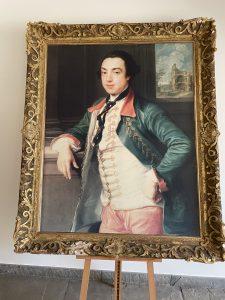 |
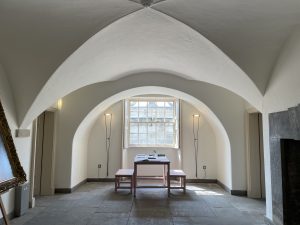 |
| Portrait of the Casino Marino’s commissioner- James Caulfeild [that’s not a typo, by the way], the 1st Earl of Charlemont. He engaged Scottish architect William Chambers to design and build it for him. Work was started in about 1759 and took some 15 years to complete. It was only eventually finished in 1775. It’s thought that Chambers never actually visited the building he designed |
In one of the basement rooms where meals were prepared for Caulfeild’s guests. There was an elaborate ventilation system which circulated the aromas of the cooking food up to the dining room, presumably to help diners to work up an appetite for the multi-course extravaganzas he liked to lay on.
I was a bit alarmed to learn though that Caulfeild used slaves in the preparation of the food, and they were kept down here and never allowed to be seen by the visiting dignitaries. |
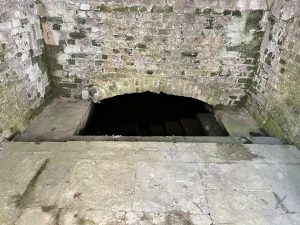 |
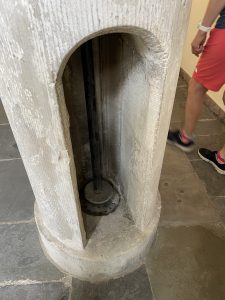 |
Now this is interesting. It’s the entrance to one of several tunnels leading from the Casino. Their purpose isn’t entirely clear but some may have been underground grottoes with bathing pools. It’s possible that Caulfeild may have used the pools to try to ease the various ailments he contracted as a result of what the Irish Times tantalisingly describes as “An unfortunate amorous escapade” while in Europe on his Grand Tour in the 1750s. It also is thought that at least one of them might have been intended to link up to the main Caulfeild mansion (now demolished) at Marino about 1km / half a mile away. But he ran out of money before it could be completed.
More recently, in 1921 during the War of Independence, the longest tunnel was used by Revolutionary leader Michael Collins “secretly” to test illicit weaponry. But apparently the tunnel amplified the sound of the shooting so that it could be clearly heard even from far away. I imagine he abandoned the practice fairly quickly. |
The Casino has a complex and impressive rain drainage system. Rainwater collected on the roof and was channelled into stone columns which had been hollowed out down the middles to create pipes that were structural as well as hydrologic. The water cascaded through the columns and was collected in a tank somewhere below ground level. I’d love to come back on a rainy day and see them in action! |
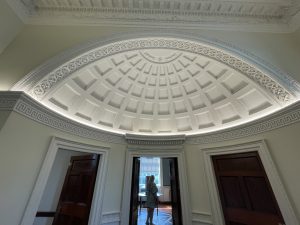 |
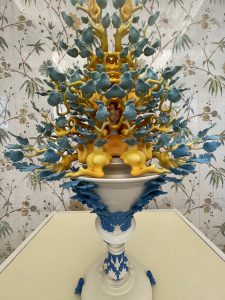 |
| Inside the ground floor Vestibule, looking into the main Salon, where the banquets were held. The plasterwork on the half-dome is meant to mimic the Pantheon in Rome. It’s all still the original work and it’s very impressive. There is lots of similar stucco in many of the rooms, though it’s less impressive in the rooms that were built towards the end of the project as Caulfield was running out of money and couldn’t afford more elaborate designs. He also had a habit, allegedly, of not paying his bills so perhaps some artists may have been a bit reluctant to work for him. |
When he was on his Grand Tour, Caulfeild ran into the Italian architect Giovanni Battista Piranesi and was very taken with his work. Some of Piranesi’s designs are incorporated into the Casino (though not as many as perhaps Caulfeild might have wanted because the Casino’s designer, William Chambers, didn’t like his work).
At the moment, the OPW has laid on an exhibition of modern artwork which supposedly echoes Piranelli’s designs, and it’s on show in Dublin Castle and in the Casino. This is one of the pieces on display – I can’t say if it really mimics Piranelli or not, but thought it looked spectacular. Even though I have no idea what it actually is. |
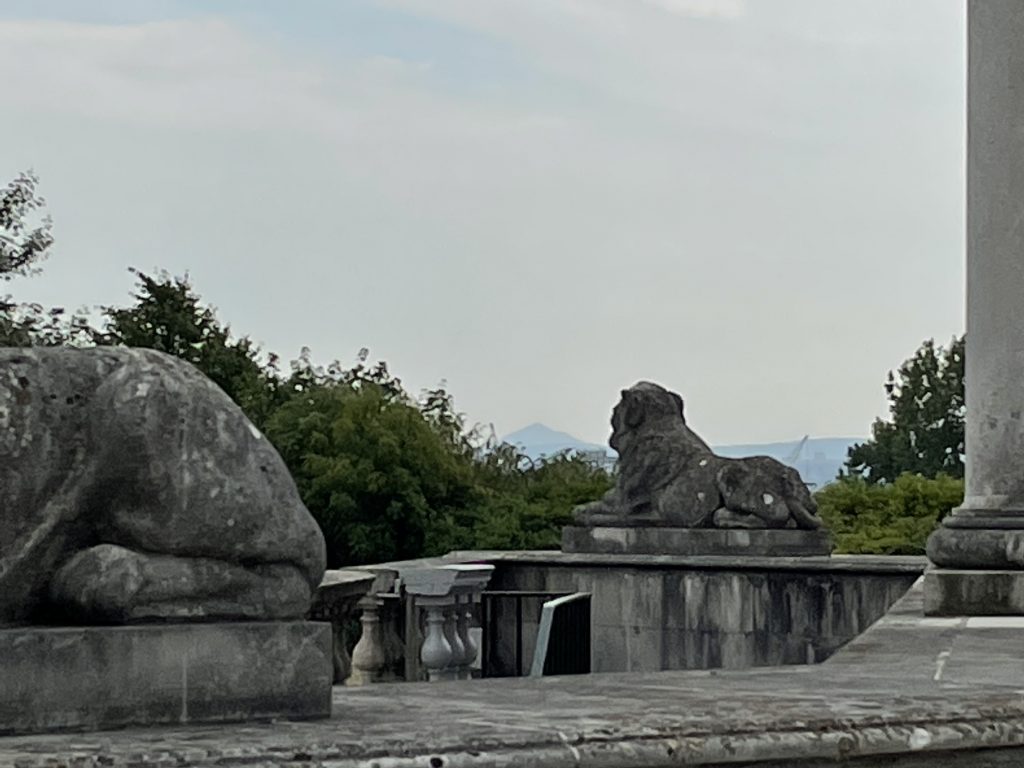 |
| Outside the Casino. I like the way the faux Egyptian lion overlooks the Great Sugarloaf mountain. Caulfeild wanted to create the illusion that he was sitting in the Casino on summer evenings overlooking not Dublin Bay, but the Bay of Naples, and that Mt Vesuvius, not the Sugarloaf, was the conical peak on the horizon |
Interactive map
(No map today)
You can read earlier and later days’ blogs below
Previous day’s blog
Next day’s blog
Ireland home page
